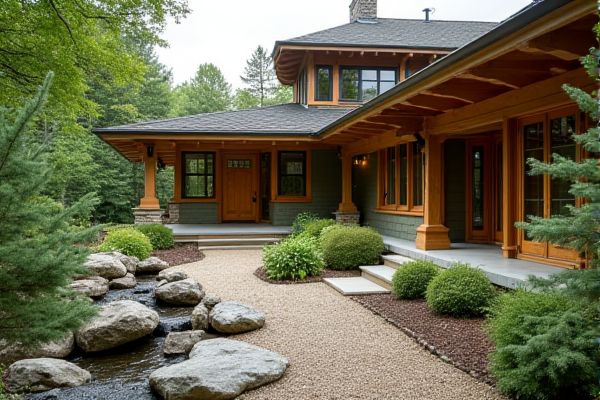
A dry creek bed is a landscaping feature designed to mimic a natural stream, efficiently directing water runoff and preventing erosion, while a rain garden is a shallow, planted depression that absorbs and filters rainwater to reduce stormwater runoff and improve water quality. Understanding the differences and benefits of each option can help you choose the best solution for your yard--read on to explore their unique features in detail.
Table of Comparison
| Feature | Dry Creek Bed | Rain Garden |
|---|---|---|
| Purpose | Redirects stormwater; erosion control | Absorbs stormwater; filters pollutants |
| Design | Gravel or rocks; dry channel | Shallow planted depression |
| Vegetation | Low-maintenance drought-tolerant plants | Water-loving native plants |
| Water Management | Conveys runoff to drains or infiltration areas | Promotes infiltration and groundwater recharge |
| Maintenance | Remove debris, occasional rock realignment | Weeding, mulching, and plant care |
| Location Suitability | Sloped areas prone to erosion | Flat or gently sloped areas |
Introduction to Dry Creek Beds and Rain Gardens
Dry creek beds and rain gardens are effective landscaping solutions designed to manage stormwater runoff and prevent soil erosion. Dry creek beds mimic natural waterways with rocks and gravel to direct excess water, while rain gardens use native plants to absorb and filter rainwater. You can enhance your property's drainage and environmental impact by choosing the best option based on your land's terrain and water flow.
Key Differences Between Dry Creek Beds and Rain Gardens
Dry creek beds are designed primarily for drainage and erosion control, channeling water away through a naturally-styled, gravel-lined trench, while rain gardens focus on water infiltration and pollution filtration using deep-rooted native plants. Unlike dry creek beds that emphasize water conveyance and aesthetic landscape accents, rain gardens function as bio-retention systems, improving groundwater recharge and removing contaminants from runoff. The key differences include their primary purpose--drainage vs. water quality improvement--and structural design, with dry creek beds using rocks to guide flow and rain gardens employing soil and vegetation to absorb and filter stormwater.
Primary Functions and Benefits
A dry creek bed primarily directs and manages stormwater runoff, reducing erosion and preventing flooding by channeling water through natural-looking pathways. A rain garden absorbs and filters rainwater, improving groundwater recharge while removing pollutants and promoting native plant growth. Choosing between the two depends on your landscape's drainage needs and goals for water management and ecological enhancement.
Design Considerations for Homeowners
Dry creek beds require careful grading to ensure proper water flow and erosion control, making them ideal for properties with noticeable slopes or drainage issues. Rain gardens demand selection of native, water-tolerant plants and soil amendments to maximize infiltration and pollutant filtration in areas with periodic standing water. Both landscape features must align with local climate, soil type, and homeowner maintenance capabilities to achieve effective stormwater management and enhance property aesthetics.
Site Selection and Soil Preparation
Dry creek beds require well-draining soil and a sloped site to mimic natural water flow, preventing erosion and pooling. Rain gardens thrive in flatter areas with soils that retain moisture but also allow infiltration, often needing soil amendments like organic matter or sand to improve drainage and nutrient balance. Your site's topography and soil type dictate the best approach to water management and plant health in these sustainable landscape features.
Plant Choices for Each Approach
Dry creek beds require drought-tolerant plants such as ornamental grasses, sedums, and native succulents to thrive in well-drained conditions. Rain gardens benefit from water-loving plants like buttonbush, swamp milkweed, and blue flag iris that handle periodic flooding and promote water absorption. Selecting species native to the regional climate optimizes both dry creek beds and rain gardens for sustainability and ecological balance.
Water Management and Drainage Performance
Dry creek beds effectively manage water by channeling excess runoff through naturalistic stone-lined pathways, reducing soil erosion and promoting infiltration over time. Rain gardens enhance drainage performance by capturing and filtering stormwater in vegetated basins, improving groundwater recharge while removing pollutants. Both methods optimize water management by mitigating flooding risks and supporting sustainable urban drainage systems.
Maintenance Requirements and Longevity
Dry creek beds require minimal maintenance, primarily occasional debris removal and weed control, ensuring long-term functionality with proper design. Rain gardens demand more consistent upkeep, including seasonal pruning, mulching, and monitoring plant health to maintain effective water absorption and aesthetic appeal. Your choice depends on the desired level of upkeep and the longevity benefits suited to your landscape needs.
Aesthetic Appeal and Landscape Integration
Dry creek beds create a natural, rustic aesthetic that mimics the look of a flowing stream, integrating seamlessly into rock gardens and drought-tolerant landscapes. Rain gardens offer vibrant bursts of seasonal color with native plants and flowers, enhancing biodiversity and softening the landscape with lush greenery. Both features improve drainage while complementing various garden styles, with dry creek beds emphasizing texture and structure, and rain gardens focusing on plant diversity and ecological function.
Choosing the Best Option for Your Yard
Selecting between a dry creek bed and a rain garden depends on your yard's drainage needs and aesthetic preferences. Dry creek beds effectively channel excess water away from structures, preventing erosion, while rain gardens absorb runoff, enhancing groundwater recharge and supporting native plants. Consider soil type, sun exposure, and maintenance when deciding the best solution for your yard's water management.
 homyna.com
homyna.com